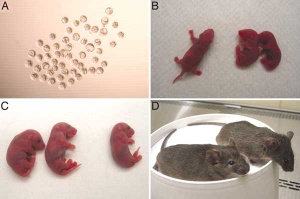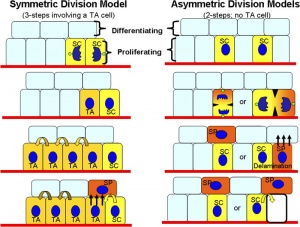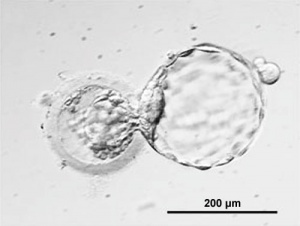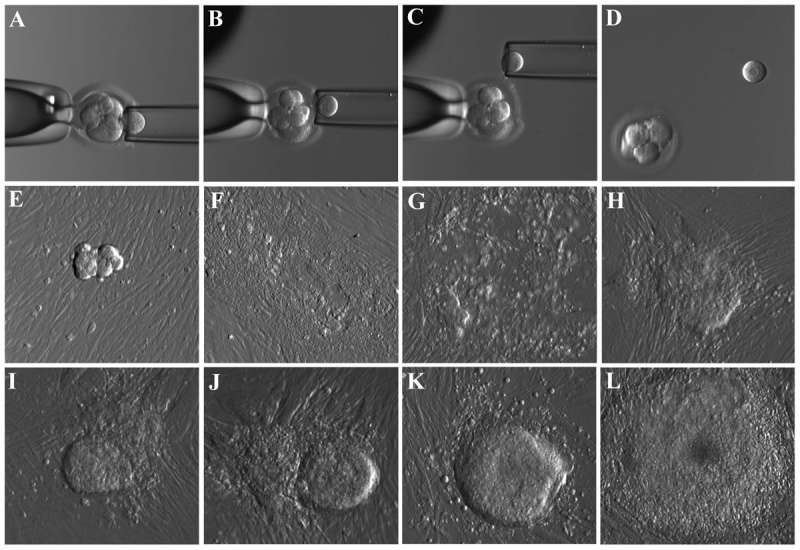Stem Cells: Difference between revisions
| Line 20: | Line 20: | ||
|-bgcolor="F5FAFF" | |-bgcolor="F5FAFF" | ||
| | | | ||
* '''Stem Cell Treatment for Eye Disease''' Sydney April 2012 [[ | * '''Stem Cell Treatment for Eye Disease''' Sydney April 2012 [[Media:Stem_cell_meeting_program_Apr2012.pdf|Meeting Program]] | ||
* '''First Successful Transplantation of a Synthetic Tissue Engineered Windpipe''' [http://ki.se/ki/jsp/polopoly.jsp?d=130&a=125055&l=en&newsdep=130 Karolinska Institute] | [http://www.ucl.ac.uk/news/news-articles/1107/11070701 University College London] | [http://news.bbc.co.uk/2/hi/health/7735696.stm BBC News] "An international team designed and built the nanocomposite tracheal scaffold and produced a specifically designed bioreactor used to seed the scaffold with the patient´s own stem cells. The cells were grown on the scaffold inside the bioreactor for two days before transplantation to the patient. Because the cells used to regenerate the trachea were the patient's own, there has been no rejection of the transplant and the patient is not taking immunosuppressive drugs." | * '''First Successful Transplantation of a Synthetic Tissue Engineered Windpipe''' [http://ki.se/ki/jsp/polopoly.jsp?d=130&a=125055&l=en&newsdep=130 Karolinska Institute] | [http://www.ucl.ac.uk/news/news-articles/1107/11070701 University College London] | [http://news.bbc.co.uk/2/hi/health/7735696.stm BBC News] "An international team designed and built the nanocomposite tracheal scaffold and produced a specifically designed bioreactor used to seed the scaffold with the patient´s own stem cells. The cells were grown on the scaffold inside the bioreactor for two days before transplantation to the patient. Because the cells used to regenerate the trachea were the patient's own, there has been no rejection of the transplant and the patient is not taking immunosuppressive drugs." | ||
* '''Culture of human pluripotent stem cells using completely defined conditions on a recombinant E-cadherin substratum'''<ref><pubmed>20525219</pubmed></ref> "huES and human induced pluripotent stem (hiPS) cells were grown on plates coated with a fusion protein consisting of E-cadherin and the IgG Fc domain using mTeSR1 medium. Cells grown under these conditions maintained similar morphology and growth rate to those grown on Matrigel and retained all pluripotent stem cell features, including an ability to differentiate into multiple cell lineages in teratoma assays." | * '''Culture of human pluripotent stem cells using completely defined conditions on a recombinant E-cadherin substratum'''<ref><pubmed>20525219</pubmed></ref> "huES and human induced pluripotent stem (hiPS) cells were grown on plates coated with a fusion protein consisting of E-cadherin and the IgG Fc domain using mTeSR1 medium. Cells grown under these conditions maintained similar morphology and growth rate to those grown on Matrigel and retained all pluripotent stem cell features, including an ability to differentiate into multiple cell lineages in teratoma assays." | ||
Revision as of 08:55, 2 March 2012
Introduction
The term "stem cell" is used so freely these days in many different forums that it is difficult sometimes understand without context what scientists, politicians, ethicists and commentators are discussing. In terms of human development, the embryonic stem cell with totipotential occurs at the blastocyst stage, mainly in the first and second week of development. After this period the inner cell mass, which forms the entire embryo, will differentiate into embryonic germ layers with restricted differentiation potential.
Stem cells as well as having the capacity to differentiate into any (totipotential) or multiple (pluripotential) cell types, have the unique capacity of self-renewal.
In vitro fertilization and growth of the blastocyst, allows isolation of these cells and their subsequent use in stem cell research. It is the collection, production and possible therapeutic applications of these stem cells which has recently attracted worldwide attention.

A key step in the development of stem cell research has been the identification of cell surface markers (proteins) which identify these cells and their state of undifferentiation.
A useful guide (online PDF document) to stem cells was produced in a report by the National Institute of Health (NIH, USA, May 2000) Stem Cells: A Primer (note large size - 4.84 Mb) and more recently NIH has established a Stem Cell information page.
Some Recent Findings

|
Embryonic Stem Cell
Human blastocyst derived stem cells[5]
(A–D) - stepwise procedure of embryo biopsy using inverted microscope-attached micro manipulator.
(E–L) - appearance of initial outgrowth and hESC colony during the derivation procedure.
Cord Blood Stem Cell
Placental cord blood is a rich souce of haematopoietic stem cells for transplantation. Cord blood can collected at birth, with no impact on the mother or neonate, and stured in cord blood banks for later use. BBC (UK) A brief article on Cord Blood stem cells and their therapeutic potential.
Spermatogonial Stem Cell (SSC)
In the male testes are a population of spermatogonia cells that differentiate and meiotically divide to form spermatozoa cells (male germ cells).
- Production of knockout mice by random or targeted mutagenesis in spermatogonial stem cells.[6]
- Spermatogonial stem cells: questions, models and perspectives.[7]
- [Spermatogonial stem cells: characteristics and experimental possibilities.[8]
- Genetic and epigenetic properties of mouse male germline stem cells during long-term culture.[9]
- Expansion of murine spermatogonial stem cells through serial transplantation.[10]
Adult Stem Cell

Adult stem cells, with pluropotentiality, are found in several body systems: intestinal epithelium, epidermis, testis and bone marrow.
- Generation of pluripotent stem cells from adult human testis[12]"Human primordial germ cells and mouse neonatal and adult germline stem cells are pluripotent and show similar properties to embryonic stem cells. Here we report the successful establishment of human adult germline stem cells derived from spermatogonial cells of adult human testis."
- Links: Stem Cells - Adult
Inducible Stem Cells
Inducible pluripotent stem cells (iPS) require a minimum of key defined transcription factors (Oct3/4, Sox2, Klf4, c-Myc, Nanog and Lin28) are required to be introduced into a cell to "induce" that cell to revert to a stem cell phenotype.
- Induction of pluripotent stem cells from adult human fibroblasts by defined factors.[13]
- Generation of induced pluripotent stem cells by reprogramming mouse embryonic fibroblasts with a four transcription factor, doxycycline inducible lentiviral transduction system.[14]
- Links: Stem Cells - Induced
Nuclear Transfer
This technique involves removing the nucleus from an early stage embryo and replacing with the nucleus from another cell. If the replacement nucleus is from a somatic cell, not a gamete, the technique is also described as somatic cell nuclear transfer (SCNT). The most famous of which was the sheep "Dolly". More recently nuclei have been sourced from a number of different tissues, including those from long-term frozen animals.[15]
For a recent review of this technique see.[16]
Stem Cell Regulation
Embryonic stem cell signaling regulation (mouse)[17]
Stem Cell Markers
In order to carry out research on stem cells, it is important to be able to identify them. A number of different research groups in the late 90's generated several antibodies which specifically identified undifferentiated, differentiating or differentiated stem cells from a number of different sources and species. Note that the nomenclature in some cases is based upon the antibody used to identify the cell surface marker.
- Stage-Specific Embryonic Antigen-1 (SSEA-1) cell surface embryonic antigen which has a role in cell adhesion, migration and differentiation and is often differentially expressed during development. Can be identified by Davor Solter (monoclonal antibody MC-480) (SSEA-1).
- Stage-Specific Embryonic Antigen-4 (SSEA-4) cell surface embryonic antigen of human teratocarcinoma stem cells (EC), human embryonic germ cells (EG) and human embryonic stem cells (ES) which is down-regulated following differentiation of human EC cells. Antigen not expressed on undifferentiated murine EC, ES and EG cells but upregulated on differentiation of murine EC and ES cells. Can be identified by Davor Solter (monoclonal antibody MC-813-70) (SSEA-4)
- Tumor Rejection Antigen (TRA-1-60) Sialylated Keratan Sulfate Proteoglycan expressed on the surface of human teratocarcinoma stem cells (EC), human embryonic germ cells (EG) and human embryonic stem cells (ES).
- Tumor Rejection Antigen (TRA-1-81) antigen expressed on the surface of human teratocarcinoma stem cells (EC), human embryonic germ cells (EG) and human embryonic stem cells (ES). Both TRA antibodies identify a major polypeptide (Mr 240 kDa) and a minor polypeptide (Mr 415 kDa).
- Oct-4 (Pou5f1) gene has an essential role in control of developmental pluripotency (Oct4 knockout embryo blastocysts die at the time of implantation). Oct4 also has a role in maintaining viability of mammalian germline.
- Stem Cell Antigen 1 (Sca-1) member of the Ly-6 family of GPI-linked surface proteins (Mr 18 kDa) and a major phenotypic marker for mouse hematopoietic progenitor/stem cell subset.
- CD133, AC133, prominin 5 transmembrane glycoprotein (865 aa) expressed on stem cells with hematopoietic and nonhematopoietic differentiation potential.
- Alpha 6 integrin
Data based on information from Appendix E.II. NIH Report "Stem Cells: Scientific Progress and Future Research Directions", Chemicon International- Stem cell marker antibodies OMIM and other sources.
Human embryonic stem cell
A recent paper identified the expression pattern of a new human embryonic stem cell line (hESC).[18]
- alkaline phosphatase
- human telomerase reverse transcriptase
- SSEA-3, SSEA-4
- TRA-1-60, TRA-1-81
- OCT-4, Nanog
- Rex-1, Sox-2, UTF-1, Connexins 43 and 45
- TERF-1 and TERF-2
- Glut-1, BCRP-1/ABCG-2, GDF3, LIN28, FGF4, Thy-1
- Cripto1/TDGF1, AC133
- SMAD1/2/3/5
Opinion on Stem Cell Use
Results from a recent Australian survey into couples' views on the use of supernumerary embryos:[19]
- 40% (123/311) returned completed questionnaires.
- 42% most common decision was donation to research (altruistic motives and desire not to waste embryos were determinants of embryo donation).
Determinants of disposal were not wanting a full sibling to existing children and opposition of embryo research.
- 45% found deciding distressing.
- 69% approved of embryo donation to stem-cell research.
Stem Cell Fake Result
Hwang Woo-suk (Korean pioneer of stem cell research) Resigns A Seoul National University investigation of the original data in Science paper Jun (2005;308: 1777-83) "Eleven human embryonic stem cells (hESC) lines were established by nuclear transfer (SCNT; NT) of skin cells from patients with disease or injury into donated oocytes." announced 29 Dec 2005 that he had faked the results.
The journal Science retracted the original paper, the original reference with link to the erratum.[20]
Science News 06 Jan | Special Online Collection: Hwang et al. and Stem Cell Issues
Cancer
There is a hypothesis that several cancers may arise from somatic stem or progenitor cells that exist in different tissues. These cancer stem cells are called "side population" (SP) cells and have been identified in: leukemia, breast cancer and several human cancer cell lines (central nervous system, gastrointestinal tumors, retinoblastoma). There is still a "chicken and egg" problem to be resolved, in that the cancer cells may have dedifferentiated to a stem cell-like population.
A recent paper has also identified SP cells in ovarian cancer which have properties similar to stem cells.[21]
References
- ↑ <pubmed>17299040</pubmed>| PMC1815251
- ↑ <pubmed>20525219</pubmed>
- ↑ <pubmed>20644535</pubmed>
- ↑ <pubmed>19570509</pubmed>
- ↑ Giritharan G, Ilic D, Gormley M, Krtolica A. Human embryonic stem cells derived from embryos at different stages of development share similar transcription profiles. PLoS One. 2011;6(10):e26570. PMID 22039509| PLoS One.
- ↑ <pubmed>16679411</pubmed>
- ↑ <pubmed>16446319</pubmed>
- ↑ <pubmed>16480445</pubmed>
- ↑ <pubmed>16107472</pubmed>
- ↑ <pubmed>12493728</pubmed>
- ↑ <pubmed>18209104</pubmed>JCB
- ↑ <pubmed>18849962</pubmed>
- ↑ <pubmed>18035408</pubmed>
- ↑ <pubmed>19915522</pubmed>
- ↑ <pubmed>18981419</pubmed>
- ↑ <pubmed>20203432</pubmed>
- ↑ <pubmed>20875146</pubmed>| PMC2946285 | BMC Biol.
- ↑ <pubmed>20973834</pubmed>
- ↑ <pubmed>16716313</pubmed>
- ↑ <pubmed>15905366</pubmed>
- ↑ <pubmed>16574858</pubmed>
Journals
- Cell Stem Cell is the official affiliated journal of the International Society for Stem Cell Research (ISSCR).
- Stem Cells welcomes original articles and concise reviews describing basic laboratory investigations of stem cells and the translation of their clinical aspects of characterization and manipulation from the bench to patient care. The journal covers all aspects of stem cells: embryonic stem cells; tissue-specific stem cells; cancer stem cells; the stem cell niche; stem cell genomics and proteomics; and translational and clinical researc
Reviews
<pubmed>19570509</pubmed> <pubmed>16574858</pubmed> <pubmed>16212509</pubmed>
Articles
<pubmed>20369364</pubmed> <pubmed>16728281</pubmed> <pubmed>16723974</pubmed> <pubmed>16719047</pubmed> <pubmed>16716780</pubmed> <pubmed>16716313</pubmed> <pubmed>16574858</pubmed>
Search PubMed
May 2006 "stem cell" 154,176 reference articles of which 16,449 were reviews.
Search PubMed Now: stem cell | embryonic stem cell | adult stem cell |
Australia
The Australian Health Ethics Committee was approached by human research ethics committees (HRECs) seeking advice on how to review research protocols that involve stem cell research. The following guidance is interim. Formal guidelines will be developed by AHEC in the context of its review of the 1996 NHMRC Ethical guidelines on assisted reproductive technology.
INFORMATION FOR HUMAN RESEARCH ETHICS COMMITTEES SHEET NUMBER 5 - STEM CELL RESEARCH
USA
National Institute of Health (NIH) Stem Cell Information NIH Stem Cell Basics | NIH Stem Cell Information | NIH Stem Cell Reports | Regenerative Medicine 2006 | Stem Cells: Scientific Progress and Future Research Directions (2001) | National Human Genome Research Institute - Cloning/Embryonic Stem Cells
Stem Cell News (2001)
During the earlier Bush administration there was much political controversy about Stem cells in the USA.
- FDA Letter to Senator Edward M. Kennedy Regarding Stem Cells, September 5, 2001
- Secretary Thompson's Oral Testimony before the Senate Health, Education, Labor and Pensions Committee, September 5, 2001
- National Institutes of Health and WiCell Research Institute, Inc., Sign Stem Cell Research Agreement, September 5, 2001
- National Institutes of Health (NIH) Update on Existing Human Embryonic Stem Cells, August 27, 2001
- Statement by Tommy G. Thompson, Secretary of Health and Human Services, Regarding Stem Cell Lines, August 27, 2001
- Video Broadcast - Briefing by HHS Secretary Tommy G. Thompson on Federal Funding of Human Embryonic Stem Cell Research, August 10, 2001
- NIH Statement on the President's Stem Cell Address, August 9, 2001
- White House Fact Sheet on Embryonic Stem Cell Research, August 9, 2001
- Statement by HHS Secretary Tommy G. Thompson Regarding the President's Decision on Human Embryonic Stem Cell Research, August 9, 2001
- Approval Process for the Documentation of Compliance with the NIH Guidelines on the Use of Human Pluripotent Stem Cells in NIH Research Proposed for Support Under Grants and Cooperative Agreements, November 21, 2000
- Approval Process for the Documentation of Compliance with NIH Guidelines on the Use of Human Pluripotent Stem Cells in NIH Intramural Research, January 16, 2001
External Links
Original UNSW Embryology Pages
- Stem Cells | Stem Cell Ethics | Cord Blood | Adult Stem Cells | Neural Stem Cells | Week 2 Stem Cells | Cloning
- StemBook - Table of Contents
- International Society for Stem Cell Research (ISSCR) is an independent, nonprofit organization formed in 2002 to foster the exchange of information on stem cell research.
- University of Michigan Stem Cells Explained
- Transcript of discussion on ABC Radio (Dr. J Kahn , Dr. JWagner) on Genetic Technology And Ethics
- A brief article on Cord Blood stem cells and their therapeutic potential from the BBC.
- Monash University (Australia) Monash Immunology and Stem Cell Laboratories (MISCL)
Human Stem cells in the News
Mainly in regard to USA political position on Human Stem Cell Research (BBC links)
- Bush stem cell move widely (10 August)
- Press see 'political' stem cell decision (10 August)
- Bush facing stem cell storm (10 August)
- Stem cell compromise angers hardliners (10 August)
- Stem cells: Q & A (10 August)
- Japan set to embrace stem cell research (1 August)
- Read this May 2000 article on Stem Cells from NIH USA
The external link to CNN requires Quicktime Stem Cell Animation
Glossary Links
- Glossary: A | B | C | D | E | F | G | H | I | J | K | L | M | N | O | P | Q | R | S | T | U | V | W | X | Y | Z | Numbers | Symbols | Term Link
Cite this page: Hill, M.A. (2024, May 5) Embryology Stem Cells. Retrieved from https://embryology.med.unsw.edu.au/embryology/index.php/Stem_Cells
- © Dr Mark Hill 2024, UNSW Embryology ISBN: 978 0 7334 2609 4 - UNSW CRICOS Provider Code No. 00098G


